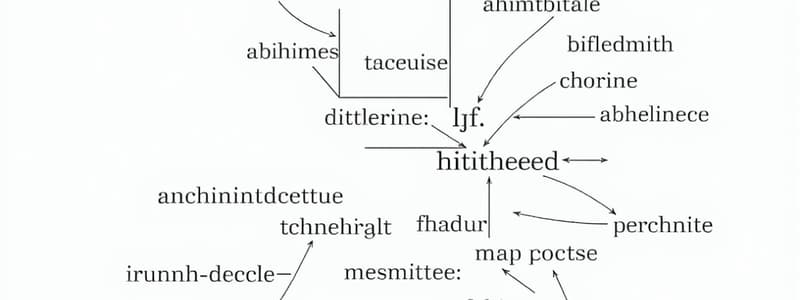Podcast
Questions and Answers
Which branch of linguistics focuses on the sounds of human speech?
Which branch of linguistics focuses on the sounds of human speech?
- Phonology
- Syntax
- Morphology
- Phonetics (correct)
What is the primary focus of semantics in linguistics?
What is the primary focus of semantics in linguistics?
- The rules that govern sentence structure
- The influence of context on language interpretation
- The structure and formation of words
- The study of meaning in language (correct)
Which term describes the vocabulary of a language?
Which term describes the vocabulary of a language?
- Lexicon (correct)
- Morphology
- Grammar
- Syntax
Which of the following best defines prescriptive linguistics?
Which of the following best defines prescriptive linguistics?
What does the term 'language universals' refer to?
What does the term 'language universals' refer to?
Which linguistic theory emphasizes the relationship between language structure and its practical use in communication?
Which linguistic theory emphasizes the relationship between language structure and its practical use in communication?
In sociolinguistics, what aspect of language is primarily studied?
In sociolinguistics, what aspect of language is primarily studied?
Who is known for developing theories of generative grammar?
Who is known for developing theories of generative grammar?
Flashcards are hidden until you start studying
Study Notes
Overview of Linguistics
- Definition: The scientific study of language, its structure, usage, and the cognitive processes behind it.
- Branches of Linguistics:
- Phonetics: Study of sounds in human speech.
- Phonology: Study of how sounds function within a particular language or languages.
- Morphology: Study of the structure and formation of words.
- Syntax: Study of sentence structure and the rules that govern sentence formation.
- Semantics: Study of meaning in language.
- Pragmatics: Study of how context influences the interpretation of meaning.
Key Concepts
- Language Universals: Features or characteristics common to all human languages.
- Descriptive vs. Prescriptive Linguistics:
- Descriptive: Analyzes and describes how language is used in practice.
- Prescriptive: Dictates how language should be used according to certain standards.
Language Components
- Lexicon: The vocabulary of a language, including words and their meanings.
- Grammar: The system and structure of a language, including syntax and morphology.
Language Acquisition
- First Language Acquisition: The process by which infants acquire their native language.
- Second Language Acquisition: The process of learning a language after the first language has been established.
Sociolinguistics
- Examines how language varies and changes in social groups.
- Studies the relationship between language and social factors such as class, race, and gender.
Psycholinguistics
- Explores the cognitive processes underlying language comprehension and production.
- Investigates how language is processed in the brain.
Applied Linguistics
- Practical application of linguistic theories and methods to real-world problems.
- Areas include language teaching, translation, and language policy.
Key Figures in Linguistics
- Noam Chomsky: Known for theories of generative grammar and the concept of an innate language faculty.
- Ferdinand de Saussure: Established structural linguistics; emphasized the relational nature of language components.
Major Linguistic Theories
- Generative Grammar: A system for describing the implicit knowledge that speakers have about their language.
- Functionalism: Views language structure in terms of its practical use in communication.
Language Change
- Investigates how and why languages evolve over time, including phonetic, morphological, and syntactic changes.
Conclusion
- Linguistics is a multifaceted field that intersects with psychology, anthropology, sociology, and cognitive science, offering insights into human communication and cognition.
Overview of Linguistics
- Linguistics is the scientific study of language, encompassing its structure, usage, and cognitive processes.
- Key branches include phonetics (study of speech sounds), phonology (sound systems within languages), morphology (word structure), syntax (sentence formation rules), semantics (meaning in language), and pragmatics (contextual influence on meaning).
Key Concepts
- Language universals refer to features common across all human languages, indicating shared characteristics in linguistic systems.
- Descriptive linguistics analyzes actual language use, while prescriptive linguistics sets standards for how language should be used.
Language Components
- The lexicon is the complete vocabulary of a language, including words and their meanings.
- Grammar encompasses the rules governing the structure of a language, particularly syntax and morphology.
Language Acquisition
- First language acquisition involves how infants learn their native language naturally, while second language acquisition refers to learning a new language after establishing the first.
Sociolinguistics
- This branch examines how language varies across different social groups and how social factors such as class, race, and gender influence language use.
Psycholinguistics
- Focuses on cognitive processes involved in understanding and producing language, including how language is accessed and processed in the brain.
Applied Linguistics
- Involves practical applications of linguistic theories to address real-world issues, including language teaching, translation, and policy-making related to language.
Key Figures in Linguistics
- Noam Chomsky is notable for his theories on generative grammar and innate language capacity.
- Ferdinand de Saussure introduced structural linguistics, highlighting the relational aspects of language components.
Major Linguistic Theories
- Generative grammar describes the innate knowledge speakers have about their language.
- Functionalism views language structure as a product of its practical communication needs.
Language Change
- Examines the evolution of languages over time, focusing on changes in phonetics, morphology, and syntax, which reflect societal developments.
Conclusion
- Linguistics is an interdisciplinary field, interacting with psychology, anthropology, sociology, and cognitive science, providing insights into the nature of human communication and cognitive processes.
Studying That Suits You
Use AI to generate personalized quizzes and flashcards to suit your learning preferences.




